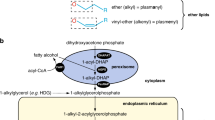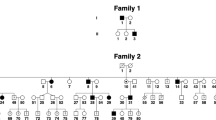Abstract
LOWE'S oculocerebrorenal syndrome1–3 (OCRL) is a human X-linked developmental disorder of unknown pathogenesis4–8 and has a pleiotropic phenotype affecting the lens, brain and kidneys. The OCRL locus has been mapped to Xq25-q26 by linkage9–11 and by finding de novoX; autosome translocations at Xq25-q26 in two unrelated females with OCRL12,13. Here we use yeast artificial chromosomes with inserts that span the X chromosomal breakpoint from a female OCRL patient in order to isolate complementary DNAs for a gene that is interrupted by the translocation. We show that the transcript is absent in both female OCRL patients with X; autosome translocations and that it is absent or abnormally sized in 9 of 13 unrelated male OCRL patients with no detectable genomic rearrangement. The open reading frame encodes a new protein with 71% similarity to human inositol polyphosphate-5-phosphatase. Our results suggest that OCRL may be an inborn error of inositol phosphate metabolism.
This is a preview of subscription content, access via your institution
Access options
Subscribe to this journal
Receive 51 print issues and online access
$199.00 per year
only $3.90 per issue
Buy this article
- Purchase on SpringerLink
- Instant access to full article PDF
Prices may be subject to local taxes which are calculated during checkout
Similar content being viewed by others
References
Lowe, C. V., Terrey, M. & MacLachan, E. A. Am. J. Dis. Child 83, 164–184 (1952).
McKusick, V. A. in Mendelian Inheritance in Man (8th edn) 1335–1336 (Johns Hopkins Univ. Press, Baltimore, 1989).
Charnas, L. R., Bernardini, I., Rader, D., Hoeg, J. & Gahl, W. A. New Engl. J. Med. 324, 1318–1325 (1991).
Yamashina, I., Yoshida, H., Fukui, S. & Funakoshi, I. Molec. cell. Biochem. 52, 107–124 (1983).
Kieras, F. J., Houck, G. E., French, J. H. & Wisniewski, K. Biochem. Med 31, 201–210 (1984).
Harper, G. S., Hascall, V. C., Yanagashita, M. & Gahl, W. A. J. biol. Chem. 262, 5637–5643 (1987).
Yoshida, H., Fukui, S. & Yamashina, I. Biochem. biophys. Res. Commun. 107, 1144–1150 (1982).
Horie, K., Yano, T., Funakoshi, I. & Yamashina, I. Clin. chim. Acta 177, 41–48 (1988).
Silver, D. N., Lewis, R. A. & Nussbaum, R. L. J. clin. Invest. 79, 282–285 (1987).
Reilly, D. S., Lewis, R. A., Ledbetter, D. H. & Nussbaum, R.L. Am. J. Hum. Genet. 42, 748–755 (1988).
Reilly, D. S., Lewis R. L. & Nussbaum, R. L. Genomics 8, 62–70 (1990).
Hodgson, S. V. et al. Am. J. Med. Genet. 23, 837–847 (1986).
Mueller, O. T. et al. Am. J. Hum. Genet. 49, 804–810 (1991).
Nelson, D. L. et al. Proc. natn. Acad. Sci. U.S.A. 88, 6157–6161 (1991).
Okabe, I., Attree, O., Bailey, L. C., Nelson, D. L. & Nussbaum, R. L. J. Inner. Metab. Dis. (in the press).
Wallace, M. R. et al. Science 249, 181–186 (1990).
Kozak, M. Nucleic Acids Res. 15, 8125–8132 (1987).
Devereux, J., Haeberli, P. & Smithies O. Nucleic Acids Res. 12, 387–395 (1984).
Altschul, S. F., Gish, W., Miller, W., Myers, E. W. & Lipman, D. J. J. molec. Biol. 215, 403–410 (1990).
Pearson, W. R. & Lipman, D. J. Proc. natl. Acad. Sci. U.S.A. 85, 2444–2448 (1988).
Ross, T. S., Jefferson, A. B., Mitchell, C. A. & Majerus, P. W. J. biol. Chem. 266, 20283–20289 (1991).
Hansen, C. A., Johanson, R. A., Williamson, M. T. & Williamson, J. R. J. biol. Chem. 262, 17319–17326 (1987).
Erneux, C. et al. Eur. J. Biochem. 181, 317–322 (1989).
Rana, R. S. & Hokin, L. E. Physiol. Rev. 70, 115–164 (1990).
Majerus, P. W. et al. Cell 63, 459–465 (1990).
Cammarata, P. R., Tse, D. & Yorio, T. Curr. Eye Res. 9, 561–568 (1990).
Cammarata, P. R., Tse, D. & Yorio, T. Diabetes 40, 731–737 (1991).
Clements, R. S. Adv. exp. med. Biol. 124, 105–131 (1979).
Scott, A. F., Phillips, J. A. & Migeon, B. R. Proc. natn. Acad. Sci. U.S.A. 76, 4563–4565 (1979).
Nussbaum, R. L., Airhart, S. D. & Ledbetter, D. H. Am. J. Med. Genet. 23, 457–466 (1986).
Sambrook, J., Fritsch, E. F. & Maniatis, T. Molecular Cloning: A Laboratory Manual (Cold Spring Harbor Laboratory, New York, 1989).
Gribskov, M. & Burgess, R. R. Nucleic Acids Res. 14, 6745–6763 (1986).
Author information
Authors and Affiliations
Rights and permissions
About this article
Cite this article
Attree, O., Olivos, I., Okabe, I. et al. The Lowe's oculocerebrorenal syndrome gene encodes a protein highly homologous to inositol polyphosphate-5-phosphatase. Nature 358, 239–242 (1992). https://doi.org/10.1038/358239a0
Received:
Accepted:
Published:
Issue Date:
DOI: https://doi.org/10.1038/358239a0
This article is cited by
-
Beyond the kidney: extra-renal manifestations of monogenic nephrolithiasis and their significance
Pediatric Nephrology (2024)
-
Hidden genetics behind glomerular scars: an opportunity to understand the heterogeneity of focal segmental glomerulosclerosis?
Pediatric Nephrology (2023)
-
PIP2 determines length and stability of primary cilia by balancing membrane turnovers
Communications Biology (2022)
-
Dent disease: classification, heterogeneity and diagnosis
World Journal of Pediatrics (2021)
-
Genetics and phenotypic heterogeneity of Dent disease: the dark side of the moon
Human Genetics (2021)



